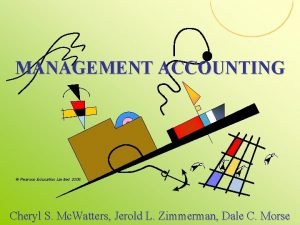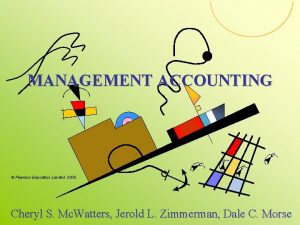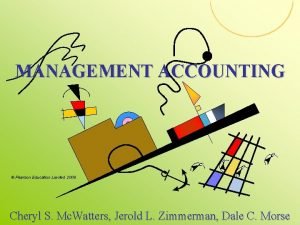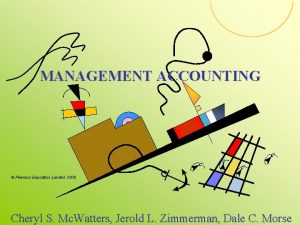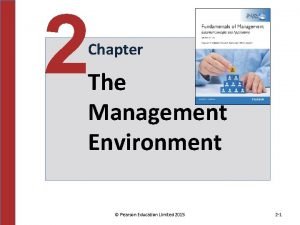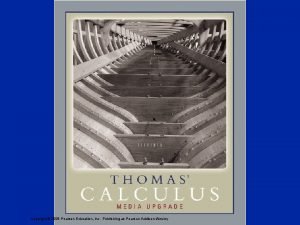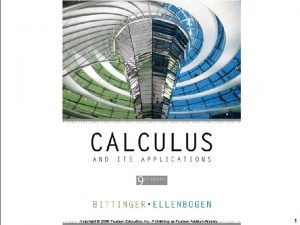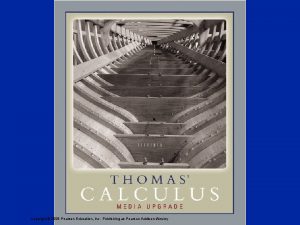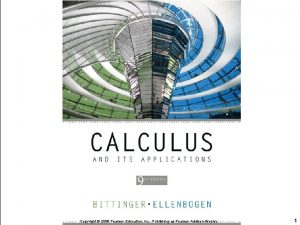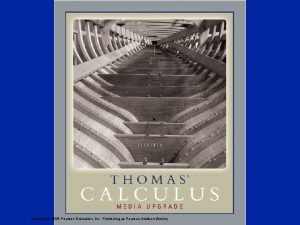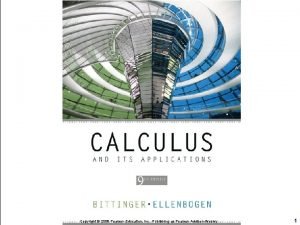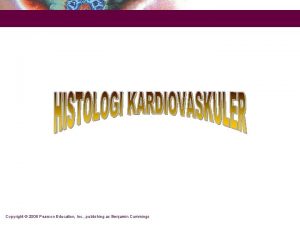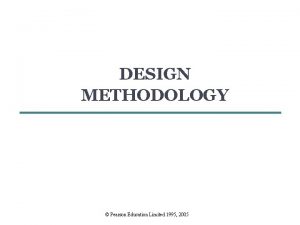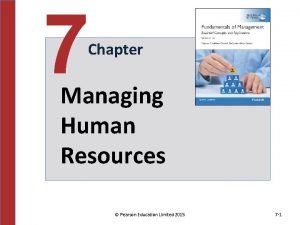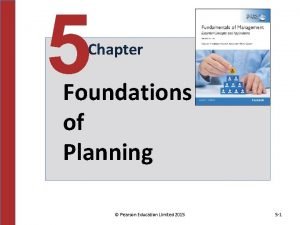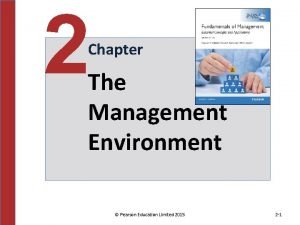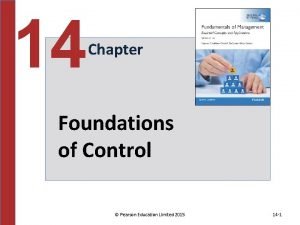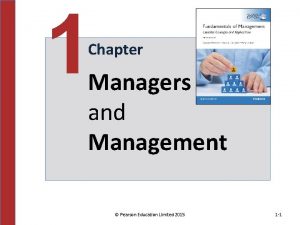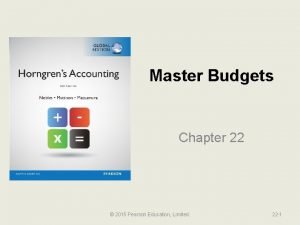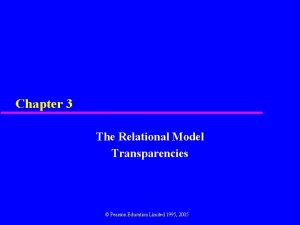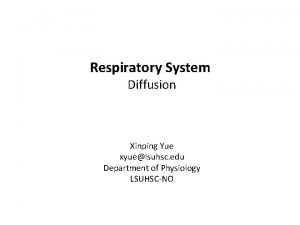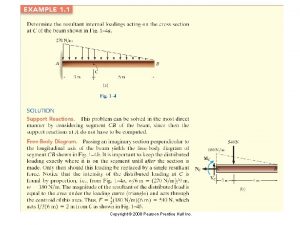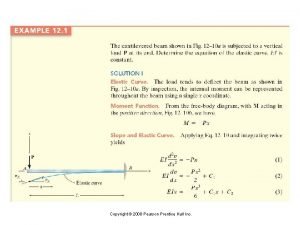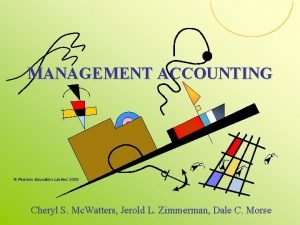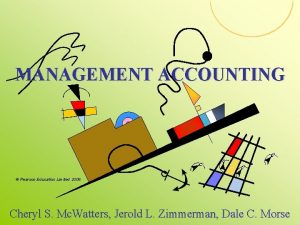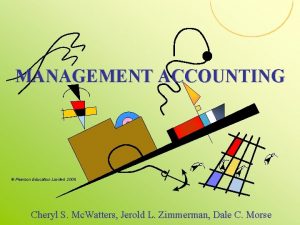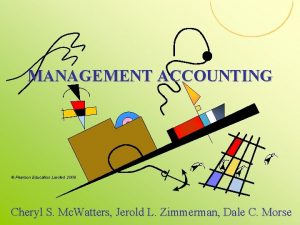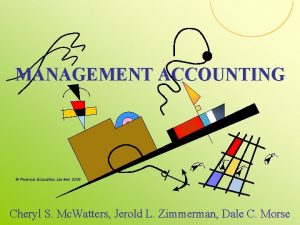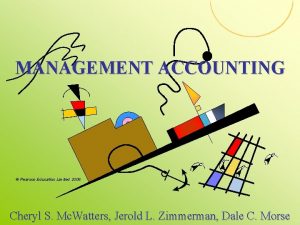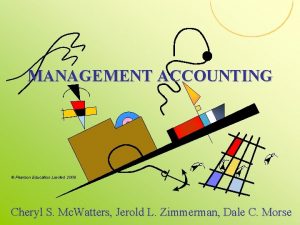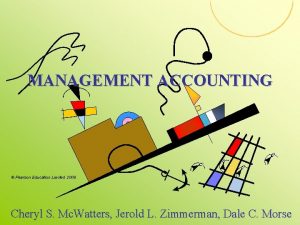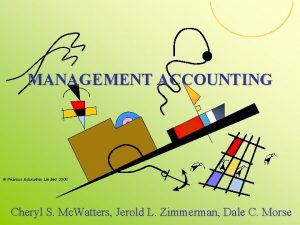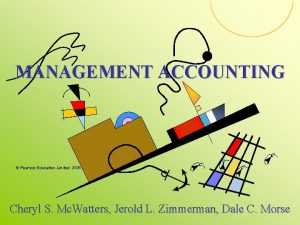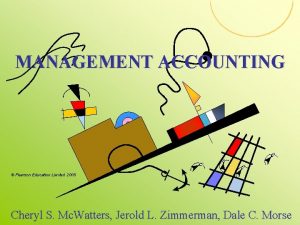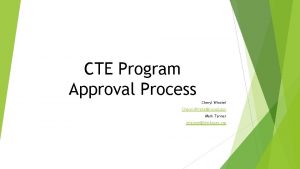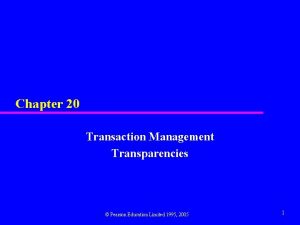MANAGEMENT ACCOUNTING Pearson Education Limited 2008 Cheryl S










































- Slides: 42

MANAGEMENT ACCOUNTING © Pearson Education Limited 2008 Cheryl S. Mc. Watters, Jerold L. Zimmerman, Dale C. Morse

12 -2 Management Accounting Standard costs and variance analysis (Control) Chapter 12 Management Accounting Mc. Watters, Zimmerman, Morse © Pearson Education Limited 2008

12 -3 Objectives • • Provide reasons for using standard costs Describe planning and control issues in setting standards Calculate direct labour and direct material variances Identify potential causes of different favourable and averse variances Recognize incentive effects of standard costs Measure expected, standard and actual usage of an allocation base to apply overhead and determine overhead variances Identify factors that influence the decision to investigate variances Summarize the costs and benefits of using standard variances Management Accounting Mc. Watters, Zimmerman, Morse © Pearson Education Limited 2008

12 -4 Standard Costs Future costs are used for planning because historical costs are not representative of future operations if conditions have changed Management Accounting Mc. Watters, Zimmerman, Morse © Pearson Education Limited 2008

12 -5 Standard Costs Expected future costs of products and services The expected level of performance Management Accounting Mc. Watters, Zimmerman, Morse Benchmarks for measuring performance Used for planning labour, material and overhead requirements © Pearson Education Limited 2008

12 -6 Reasons for Standard Costing t c u d o r g P n i ic r P Co ntr Bid act din g Planning Decisions g n i rc u o s s t n Ou cisio De Management Accounting Mc. Watters, Zimmerman, Morse As alt sessi ern ng pr od ativ de ucti e cis on ion s © Pearson Education Limited 2008

12 -7 Reasons for Standard Costing co Ba s u n o B i t a c o l al sis ntr for ac ts Control Decisions Basis for managerial performance evaluation Management Accounting Mc. Watters, Zimmerman, Morse © Pearson Education Limited 2008

12 -8 Reasons for Standard Costing Managers focus on quantities and costs that exceed standards, a practice known as management by exception Amount Standard Direct labour Direct Material Manufacturing Overhead Type of Product Cost Management Accounting Mc. Watters, Zimmerman, Morse © Pearson Education Limited 2008

12 -9 Reasons for Standard Costing This variance is unfavorable because the actual cost exceeds the standard cost Product Cost Standard Management Accounting Mc. Watters, Zimmerman, Morse A standard cost variance is the amount by which an actual cost differs from the standard cost © Pearson Education Limited 2008

12 -10 Setting and Revising Standards • Accountants, industrial engineers, personnel administrators, and production managers often combine efforts to set standards based on experience and expectations • Attainable standards should be set at levels that are currently attainable with normal and reasonable effort Standards may be set using a. . . • Bottom-up approach involving the participation of all levels of management and staff • Top-down approach called target costing Management Accounting Mc. Watters, Zimmerman, Morse © Pearson Education Limited 2008

12 -11 Setting and Revising Standards De sir Pr ed ofi t d e r e i r s De t Sha e k r a M Target Costs n r tu e R l d a e t r i i p s De n Ca o Management Accounting Mc. Watters, Zimmerman, Morse Co st R edu ctio Go n als © Pearson Education Limited 2008

12 -12 Direct Labour and Direct Materials Variances • Variances used primarily to identify problems • Variances calculated to help managers determine the cause and responsibility for the problem • By partitioning variances into component variances cause and responsibility become easier to identify – Variance due to actual price per unit differing from plan – Variance due to actual quantity per unit differing from plan Management Accounting Mc. Watters, Zimmerman, Morse © Pearson Education Limited 2008

12 -13 Direct Labour Variances Direct Labour variance is the difference between the actual direct labour costs and the standard direct labour costs Labour rate variance Management Accounting Mc. Watters, Zimmerman, Morse Labour efficiency variance © Pearson Education Limited 2008

12 -14 Direct Labour Variances Direct Labour variance = ( = Labour rate variance Actual cost of labour Standard cost of labour ) ( Actual x Actual hours - Standard x Standard labour rate Labour rate hours ( = Actual labour rate Labour efficiency = Variance ( Direct Labour variance Labour rate variance = Actual hours Management Accounting Mc. Watters, Zimmerman, Morse ) x Actual hours ) x Standard Labour rate - Standard hours + Labour efficiency Variance ) © Pearson Education Limited 2008

12 -15 Standard Cost Variances Price Variance Quantity Variance The difference between the actual price and the standard price The difference between the actual quantity and the standard quantity Management Accounting Mc. Watters, Zimmerman, Morse © Pearson Education Limited 2008

12 -16 Direct labour Variances A Favorable variance occurs when the actual costs are less than the standard costs An adverse variances occurs if the actual costs are greater than the standard costs Management Accounting Mc. Watters, Zimmerman, Morse © Pearson Education Limited 2008

12 -17 Direct Labour Variances Rate per hour, R Rate Variance Ra Rs Efficiency Variance Ra is the actual rate Rs is the standard rate Management Accounting Mc. Watters, Zimmerman, Morse Hs Ha Hours of work, H Ha is the actual hours Hs is the standard hours © Pearson Education Limited 2008

12 -18 Direct Labour Variances Numerical Example A public accounting firm estimates that an audit will require the following work: Type of auditor Expected hours Cost per hour (£) Standard costs (£) Manager 10 50 500 Senior 20 40 800 Staff 40 30 1, 200 Totals 70 2, 500 The following were the actual hours and costs Type of auditor Expected hours Cost per hour (£) Standard costs (£) Manager 9 52 468 Senior 22 38 836 Staff 44 30 1, 320 Totals 75 Management Accounting Mc. Watters, Zimmerman, Morse 2, 624 © Pearson Education Limited 2008

12 -19 Direct Labour Variances Numerical Example The direct labour variance Type of auditor Actual costs (£) Standard costs (£) Direct labour variance (£) Manager 468 500 (32) Senior 836 800 36 Staff 1, 320 1, 200 120 Totals 2, 624 2, 500 124 Adverse Labour rate variance Labour efficiency variance Manager (£ 52 - £ 50 x 9) £ 18 Manager (9 – 10 x £ 50) (£ 50) Senior (£ 38 - £ 40 x 22) £(44) Senior (22 – 20 x £ 40) £ 80 0 Staff (44 -40 x £ 30) £ 120 Total labour efficiency variance £ 150 A Staff (£ 30 - £ 30 x 44) Total labour rate variance (26) F Management Accounting Mc. Watters, Zimmerman, Morse © Pearson Education Limited 2008

12 -20 Direct Labour Variances Actual Hours Actual rate x £ 4, 886 Actual Hours x Standard rate £ 4, 835 Direct labour rate variance £ 51 Adverse Standard Hours x Standard rate £ 4, 800 Direct labour efficiency variance £ 35 Adverse Direct labour variance £ 86 Adverse Management Accounting Mc. Watters, Zimmerman, Morse © Pearson Education Limited 2008

12 -21 Direct labour Variances Poorly trained workers Poor quality materials Unfavorable Efficiency Variance Poor supervision of workers Management Accounting Mc. Watters, Zimmerman, Morse Poorly maintained equipment © Pearson Education Limited 2008

12 -22 Direct Materials Variances Direct materials variances are similar to those computed for direct labour Total direct materials variance is decomposed into a material price variance and a material quality variance Management Accounting Mc. Watters, Zimmerman, Morse © Pearson Education Limited 2008

12 -23 Direct Materials Variances Direct material variance Actual cost of material = ( = Actual price ( Actual price Standard cost - of material Actual quantity ) ( Standard price - Standard price ) x Actual quantity ) x Standard price x - Price variance = Quantity Variance = Actual quantity ( - Standard quantity Direct material variance = Price variance + Quality Variance Management Accounting Mc. Watters, Zimmerman, Morse x Standard quantity ) © Pearson Education Limited 2008

12 -24 Direct Materials Variances Price per unit on material, P Price Variance Pa Ps Quality Variance Pa is the actual price Ps is the standard price Management Accounting Mc. Watters, Zimmerman, Morse Qs Qa Units of material, Q Qa is the actual quantity Qs is the standard quantity © Pearson Education Limited 2008

12 -25 Direct Materials Variances Numerical Example A tyre manufacturer has a standard quantity of 3 kg of fibreglass cord per automobile tyre. The standard price is € 1. 00 per kg During the month the purchasing manager bought 98, 000 kg of cord for € 102, 000. The plant used 95, 000 kg of cord to manufacture 30, 000 tyres Actual purchase price € 102, 000/98, 000 = € 1. 04082/kg Material variance (€ 1. 04082 - € 1. 00/kg) x 98, 000 = € 4, 000 adverse Material quality variance (95, 000 kg – 90, 000 kg) x € 1. 00/kg = € 5, 000 adverse Management Accounting Mc. Watters, Zimmerman, Morse © Pearson Education Limited 2008

12 -26 Direct Materials Variances Actual x quantity Actual price Actual quantity £ 9, 588 x Standard price £ 9, 610 Direct material price variance (£ 22) Favourable Standard quantity x Standard price £ 9, 600 Direct material quality variance £ 10 Adverse Direct material variance (£ 12) Favourable Management Accounting Mc. Watters, Zimmerman, Morse © Pearson Education Limited 2008

Incentive Effects of Direct labour and Materials Variances 12 -27 When used as performance measures, standard cost variances create subtle incentive effects: • The incentive to build inventories • Externalities • Discouraging cooperative effort • Mutual monitoring incentives • Satisficing behaviour Management Accounting Mc. Watters, Zimmerman, Morse © Pearson Education Limited 2008

12 -28 Incentive to Build Inventories The evaluation of purchasing managers based on direct materials price variances creates incentives for these managers to build inventories This incentive can be reduced by charging the purchasing department for the cost of holding inventories An alternative mechanism for controlling inventory-building is to adopt techniques such as just-in-time manufacturing Management Accounting Mc. Watters, Zimmerman, Morse © Pearson Education Limited 2008

12 -29 Externalities Purchasing managers can impose externalities on production by purchasing sub-standard materials To offset this incentive the materials can be inspected on receipt against a set of engineering specifications An alternative mechanism would be to set a performance measure for the purchasing manager to minimize the amount of rework generated Production managers can impose externalities on purchasing by requesting materials are purchased on short lead times or in small lot sizes Management Accounting Mc. Watters, Zimmerman, Morse Engineering can increase the price of purchases by making frequent design changes © Pearson Education Limited 2008

12 -30 Unco-operative Effort Evaluating individuals within an organization based on different variances can discourage co -operative effort To encourage co-operative effort many organizations calculate variances and measure performance at multiple levels An alternative is to measure variances for a team or department within the organization Management Accounting Mc. Watters, Zimmerman, Morse © Pearson Education Limited 2008

12 -31 Mutual Monitoring Incentives Mutual monitoring occurs between managers who are not in a direct reporting relationship with each other In designing performance evaluation and reward systems, organizations can create mutual monitoring incentives that encourage managers to acquire and utilize their specialized knowledge to improve the performance of other managers Management Accounting Mc. Watters, Zimmerman, Morse © Pearson Education Limited 2008

12 -32 Satisficing Behaviour Satisficing behaviour occurs when manager have inventive to achieve a standard of performance but go no further Satisficing behaviour can affect quality if employees are motivated to meet quotas Management rewards should be based on achieving or exceeding the standard of performance Management Accounting Mc. Watters, Zimmerman, Morse © Pearson Education Limited 2008

12 -33 Standard Overhead Costs and Variances Quantity and price variances are defined in terms of the allocation base for overhead costs. • • The quantity of overhead is the level of usage of the allocation base The price of overhead is the overhead application rate Management Accounting Mc. Watters, Zimmerman, Morse © Pearson Education Limited 2008

12 -34 Expected, Standard, and Actual Usage of the Allocation Base • Expected usage is estimated at the beginning of the year and used to compute the predetermined allocation rate • Standard usage is the amount that should have been used for the actual output • Actual usage is the amount of the allocation based actually used Management Accounting Mc. Watters, Zimmerman, Morse © Pearson Education Limited 2008

Expected, Standard, and Actual Usage of the Allocation Base 12 -35 Numerical Example Pizzazz Pizza makes 2 types of pizza. The company allocates overhead based on the number of direct labour hours The direct labour hours for a pepperoni pizza is 5 minutes and the direct labour hours for a cheese pizza is 4 minutes. Pizzazz Pizza expected to make 12, 00 pepperoni and 6, 000 cheese pizzas. During the year the firm made 9, 00 pepperoni and 7, 500 cheese pizza. The labourers worked for 1, 300 hours Management Accounting Mc. Watters, Zimmerman, Morse © Pearson Education Limited 2008

Expected, Standard, and Actual Usage of the Allocation Base 12 -36 Numerical Example Expected number of direct labour hours Pepperoni (12, 000 x 0. 08) Cheese (6, 000 x 0. 07) Total 1, 000 400 1, 400 Standard number of direct labour hours Pepperoni (9, 000 x 0. 08) 750 Cheese (7, 500 x 0. 07) 500 Total 1, 250 Actual number of direct labour hours 1, 300 Management Accounting Mc. Watters, Zimmerman, Morse © Pearson Education Limited 2008

12 -37 Budgeted, Applied, and Actual Overhead Budgeted Overhead Applied Overhead Actual costs of using overhead resources Overhead costs expected at the beginning of the period Overhead costs applied to cost objects through the standard usage of the allocation base The difference between actual overhead costs and applied overhead is the total overhead variance Management Accounting Mc. Watters, Zimmerman, Morse © Pearson Education Limited 2008

12 -38 Incentive Effects of Overhead Standards and Variances Desired Result Problem Maintain the quality of overhead services while, at the same time, reducing overhead costs to obtain favorable variances Output is increased, resulting in actual overhead < applied overhead (favorable variance) and excess inventories Solution Separate responsibilities so that overhead resource manager does not control output levels Management Accounting Mc. Watters, Zimmerman, Morse © Pearson Education Limited 2008

12 -39 Variance Investigation Co st of Co rre not cti ng f o e z i e c S n a i r a V Variance Investigation Decision of st n o o i C t c e rr o C Management Accounting Mc. Watters, Zimmerman, Morse Ea Co se of rre ctio n © Pearson Education Limited 2008

12 -40 Costs and Benefits of Using Standard Costing Systems Possible reductions in production costs Management by exception Advantages Improved cost control and performance evaluation Management Accounting Mc. Watters, Zimmerman, Morse Better Information for planning and decision making © Pearson Education Limited 2008

12 -41 Costs and Benefits of Using Standard Costing Systems Emphasis on negative exceptions may lead to inappropriate behaviour Emphasis on negative exceptions may impact morale Disadvantages It may be difficult to determine which variances are significant Management Accounting Mc. Watters, Zimmerman, Morse Focus on big variances may obscure early stages of trends © Pearson Education Limited 2008

12 -42 Management Accounting Standard costs and variance analysis (Control) End of Chapter 12 Management Accounting Mc. Watters, Zimmerman, Morse © Pearson Education Limited 2008
 Pearson education limited 2008
Pearson education limited 2008 Pearson education limited 2008
Pearson education limited 2008 Pearson education limited 2008
Pearson education limited 2008 Master budget example
Master budget example Pearson education limited 2008
Pearson education limited 2008 2008 pearson education inc
2008 pearson education inc 2008 pearson education inc
2008 pearson education inc 2008 pearson education inc
2008 pearson education inc 2008 pearson education inc
2008 pearson education inc 2008 pearson education inc
2008 pearson education inc 2008 pearson education inc
2008 pearson education inc 2008 pearson education inc
2008 pearson education inc Layers and components of the artery wall
Layers and components of the artery wall Pearson education limited 2005
Pearson education limited 2005 Pearson education limited 2017
Pearson education limited 2017 Pearson education limited 2017
Pearson education limited 2017 Pearson education limited 2015
Pearson education limited 2015 Formal planning may create rigidity.
Formal planning may create rigidity. Pearson education limited 2015
Pearson education limited 2015 Pearson education limited 2015
Pearson education limited 2015 Pearson education limited 2015
Pearson education limited 2015 Pearson education limited 2015
Pearson education limited 2015 Pearson education limited 2015
Pearson education limited 2015 Pearson education limited 2015
Pearson education limited 2015 Pearson education limited 2005
Pearson education limited 2005 Pearson education, inc. publishing as prentice hall
Pearson education, inc. publishing as prentice hall Pearson education 2011
Pearson education 2011 Pearson education inc publishing as pearson prentice hall
Pearson education inc publishing as pearson prentice hall Pearson 2012
Pearson 2012 Copyright 2008
Copyright 2008 2008 2008
2008 2008 Ficks law
Ficks law 2008 pearson prentice hall inc
2008 pearson prentice hall inc 2008 pearson prentice hall inc
2008 pearson prentice hall inc Accounting responsibility
Accounting responsibility Pearson vue ceo
Pearson vue ceo Educational pearson pearson times
Educational pearson pearson times Cheryl bendtsen
Cheryl bendtsen Cheryl wold
Cheryl wold Cheryl goddard
Cheryl goddard Wcet san
Wcet san Cheryl schaub
Cheryl schaub Cheryl gta 5
Cheryl gta 5
